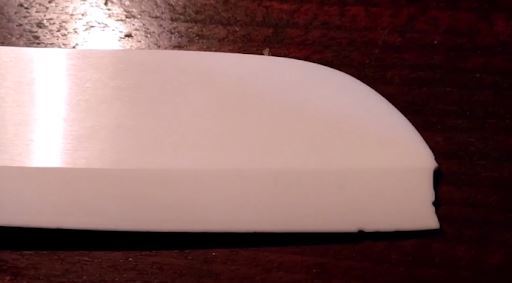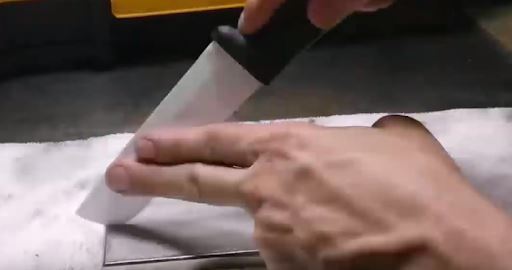Don’t you just love using those colorful knives in your kitchen? Don’t you find them very appealing to the eyes when you use them as functional decorative pieces? I am very intrigued by using these ceramic knives for basic kitchen needs. As much as I like using ceramic knives every day, there still comes a point where they get dull. So, the question now is, how to sharpen ceramic knives? Is it the same as sharpening steel knives? I’ve listed the information that would be helpful so you can sharpen your ceramic knives.
What is a Ceramic Knife?
Ceramic knives are often characterized by their black or white blade. They are made by sintering powdered zirconia or zirconium dioxide to create an incredibly hard material perfect for a knife’s blade.
Sintering is the process of applying heat and pressure on a material to make it compact without turning it to its liquid state. In simpler terms, it’s like carbon turning into diamond because of exposure to heat and pressure, packing the carbon tightly together to form a really hard material. In this case, powdered zirconia is used to form the blade of the knife.
How are They Different From Steel Knives?
Stainless steel knives and ceramic knives have a world of differences. You can tell just by looking at them. Most colored knives are ceramic knives but they’re typically either white or black. However, there are also coated stainless steel knives.
Coated stainless steel knives use a non-stick coating. The non-stick coating is an alternative for Granton edges or air pockets at the sides of the knife to prevent food from sticking to the blade. Although it has been found that due to frequent sharpening, the coating rubs off the stainless steel base over time.
Ceramic Blade | Stainless Steel Blade | |
|---|---|---|
Hardness (Mohs Scale) | 8.5 to 9.5 | 4.5 to 7 |
Manufacturing | Sintering | Forged, stamped or cladded |
Basic purpose | Used for delicate slicing | Multipurpose knife |
Frequency of sharpening | When it gets dull | Every after 4-6 uses |
Sharpening tool | Ceramic, diamond | Whet stone |
Blade quality | Very hard and sharp but brittle | Flexible and reliable but requires frequent sharpening |
Texture | Slightly rough matte feel | Smooth and straight |
What to Like and Dislike About a Ceramic Knife?
A ceramic knife is a single solid material that is possibly one of the hardest materials used to make a knife. Here are many reasons why I just absolutely love using ceramic knives:
- Very hard blade. The knife is stiff and it will easily slice through food with ease.
- Thin blade for precision cutting. Ceramic is great for precision cutting like making julienne strips, paysanne, chiffonade, and more.
- High edge retention. Since it has a hardness of about 8.5 to 9.5, it is second to diamonds when it comes to hardness. This makes the edge of the knife keeps its sharpness for a very long time.
- Totally rust resistant and corrosion-free. You never have to worry about your knife ever rusting up. Ceramic is resilient and non-reactive so it does not react to any type of chemical.
- No static energy. The reason why steel blades usually require a Granton edge or air pockets is that it has static energy that attracts the food to stick to the surface of the blade. Ceramic blade knives are somewhat a non-stick blade because food barely sticks to the surface of the knife mostly due to it not producing static.
- Doesn’t absorb scents or smells. Unlike steel, ceramic blades do not absorb the scents of the food you are slicing thus retaining their quality and integrity. You don’t want your food to start smelling funky, don’t you?
- Lightweight and Sanitary. Though ceramic blades are very lightweight, they are also made of very dense material. The density of the ceramic prevents germs from getting in between the pores of the blade. In fact, you can simply wash your knife with warm water and you are guaranteed a sanitary knife.
- High end. Ceramic knives are already high end because it is made of one of the hardest materials on earth.

No matter how much you like a certain kitchen tool, there will always be flaws. The thing I don’t like about ceramic knives are the following:
- Brittleness. Ceramic knives have a breaking point and for that reason, you cannot use them for slicing heavy loads of meat or even cutting through cartilage and bone. And there is also a good chance of breaking your knife if you accidentally drop it.
- Permanent chipping. Aside from it possibly breaking in half when you put extra pressure on the knife, the blade also chips off. Chipping, however, is irreversible. Once you chip the knife, there is nothing more you can do about it.
- Special sharpening. It takes a special sharpener to keep ceramic blades sharp. We will talk more about how to sharpen a ceramic knife below.
- Not flexible. Forcing your knife to bend will break your knife. A hard sintered material is not flexible in any way.
- Only for straight downward cutting. Because it is a stiff straight knife with usually a straight edge, a ceramic knife is meant for single downward slicing movements.
What Are the Main Uses of Ceramic Knives?
As sharp as ceramic knives are, they aren’t as versatile as you would initially think they are. Ceramic knives are very hard but they break once pressure is applied on its breaking point. They aren’t fit for slicing or cutting through tough types of meat and heavy-duty slicing like digging in-between joints. The knife is stiff and won’t bend without breaking it.
Single Downward Slicing
Ceramic knives aren’t meant for cutting activities that require you to twist or bend the knife. They are great for even slicing with a single downward stroke. They are great especially when you are trying to make equal cuts like making strips thin slices and other precise cuts.
Daily Light Use
No matter how often you make thin meat slices, peel and slice fruits, and loaves of bread, you can use ceramic knives as often as possible and not worry about it easily getting dull. You can use your ceramic knife for over six months without worry if these are the only things you’ll use it for.
Can Ceramic Knives Be Sharpened?

Yes, they can. It is a matter of knowing how to sharpen ceramic knives that’s different. The only way to sharpen ceramic knives is by using a material that is harder than ceramic and that is diamond or ceramic itself.
How to Sharpen Ceramic Knives
With proper care and use, ceramic knives will really give you a long cutting service. However, no matter how hard this material may be, it will eventually get dull at some point. Others find it difficult to sharpen ceramic knives due to the fact that typical whetstones or blade sharpeners cannot do the trick. So, how do you sharpen a ceramic knife? It starts with the right material.

Finding the Right Tool
Since the only other material hard enough to sharpen your ceramic blade is diamond, other sharpening tools won’t be able to sharpen your ceramic blade. Though some also use ceramic to sharpen the tip of a blade as an alternative (one such example are the bottom of ceramic jars, jugs or pots), it is not advisable. Using ceramic to sharpen a ceramic blade may mean two things: you will sharpen both ceramics or break them. It won’t also guarantee that you will be able to have a nicely sharpened edge afterward. The best option you have is getting yourself a diamond sharpening plate.

Sharpening a Knife Manually
To sharpen ceramic knives by hand, you need your sharpener and a knife rest. If you don’t have a rest to position your knife at an angle, you can use the scrabble stand or any other item you have in your house that can support your knife well.
- Put your knife on the rest with the edge.
- To secure the knife in place, gently press three of your fingers at the base of the knife against the rest. Don’t press too hard, just make sure that the knife won’t move about when you start sharpening your knife.
- Get a 300 (to 600) grit diamond plate, scrub the sides of the plate in a consistently back and forth manner.
- Scrub on both sides constantly and until there aren’t any chips or dull edges. To check if the edge of the knife is already sharp enough, you can try slashing the knife against a piece of paper. If the knife gives you a clean cut, it is sharpened to perfection. If it gives you a jagged slice through the paper, you can repeat the steps above.
- To polish your ceramic knife, sweep both sides of the knife using a 1000 grit diamond plate. Sweeping strokes are done simply moving the sharpener to and fro and side to side.
- Wipe the knife with a damp cloth to remove any dust or residue from the blade and put it back in its sleeve for safe keeping.

Remember: I don’t recommend that you hold the knife and sharpen your blade as you would with a high carbon steel knife. This would require you to apply pressure on the ceramic knife causing it to weaken or even break your knife.
NOTE: As much as possible limit the contact of your fingers on the blade to reduce the pressure, just gently press the tips of your fingers against the base of the blade and not anywhere near the sides of the blade.
Fixing a broken tip
You don’t have to throw away your ceramic knife. You can easily fix the chip at the tip of a knife using a 300 grit diamond plate sharpener.

- Draw a new tip at the edge of the knife using a pen. Draw as close as possible to the original tip of the knife.
- For additional support, use the tip of your fingers to guide the knife. From the back of the knife moving towards the tip, rub it against the diamond plate.
- With a gentle scrubbing motion, move the knife back and forth until you form the new tip of the knife.
- Polish the knife using a 1000 grit sharpener.

Maintaining a Ceramic Knife
Ceramic knives are pretty delicate despite being one of the hardest materials you can get your hands on. Here are some ways of keeping your knife sharp and probably even extend the life of your ceramic knife.

- Use a protective sleeve when storing. Most ceramic knives come with a protective sleeve.
- Use a plastic or wooden chopping board to prevent the knife edge from getting chipped.
- Hand wash your knife. Though ceramic knives can be washed in a dishwasher, I suggest that you don’t. There is a likelihood that other utensils will hit the knife and cause the knife to get chipped or even break.
- Always be careful in handling your knife. Don’t put it in a place where you might drop it.
- When slicing meat or tougher food, support the knife by placing the tops of your fingers at the spine of the knife. You don’t have to apply pressure but gently press down when you are going to slice.
Quick FAQs About Sharpening Ceramic Knives
Are the Diamond Plates Made of Real Diamond?
No, they are not. Diamond plates are covered with man-made micro diamonds. They are not the real expensive diamonds that you can get for thousands of dollars. These synthetic diamonds are pressurized carbon to produce these micro-gems and added on the surface of a plate to be used for sharpening tools.
Should I Look for a Certain Type of Diamond?
There are two types of diamond plate sharpeners: polycrystalline and monocrystalline surface. Polycrystalline diamond plates are rougher because the plates are covered with course-edged micro diamonds as compared to monocrystalline diamond plates which are smoother.
But for diamond sharpening stones or plates, the diamond breaks up as it is used for sharpening. Monocrystalline diamonds maintain their shape and size and are perfect in reshaping, polishing and sharpening blades especially ceramic knives. Monocrystalline diamond plates are generally more expensive.
Can I Use a Diamond Plate Sharpener Dry?
Although it is fine for you to use your sharpener dry, it is definitely not preferred. Making your plate wet means that you are adding a lubricant. When you sharpen your tools especially your ceramic knife, you are taking off a layer of the surface and those small particles of ceramic has to go somewhere. The lubricant will keep the small particles from building up on the sharpener.
Can I Use Water to Wet My Diamond Plate?
Some companies recommend the use of water. But the reality is that when you are using a diamond plate mounted on metal, it is best to use a lubricant instead. The spaces between the diamonds will prevent the water from drying out thus staying within those spaces and eventually make the metal plate underneath to rust.
What Is the Best Grit Size for Sharpening?
The lower the number of the grit size, the courser it is. Grit sizes ranging from 300 to 600 are best in sharpening a dull-edged ceramic knife a 1000 grit is best in polishing the edge of the blade.
The Final Takeaway
Ceramic knives are by far the best knives that provide the easiest tools in making simple slicing and cutting needs in your kitchen. They are long-lasting, safe to use and easy to handle. Though they can last months in your kitchen without being sharpened, they still get dull. And the best possible way of sharpening your knife at home is by using a diamond plate sharpener. With gentle scrubbing, you can easily keep the knife in tip-top shape at any time.
